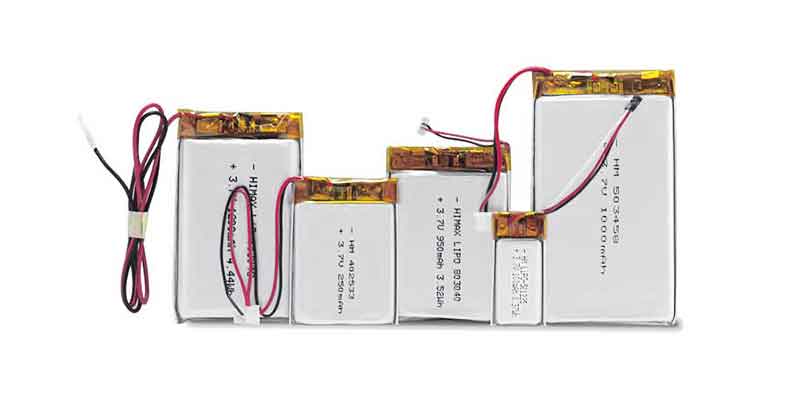How Lithium Polymer Batteries Are Made?
lithium polymer battery characteristics
Compared to most lithium polymer batteries, the lithium polymer battery is with characteristics as below:
1. No battery leakage problem
The battery does not contain a liquid electrolyte, using a colloidal solid.
2. Thin battery
Thin battery with a capacity of 3.6V400mAh, its thickness can be as thin as 0.45mm. Various Shapes
3. various shapes
The battery can be designed in various shapes: round, D, arc, etc.
4. Bending deformation
The battery can be bending deformation: polymer battery maximum bending around 90 °.
5. Single high voltage
liquid electrolyte battery can only get high voltage by several batteries in series, while polymer battery can be made into multi-layer combination in a single battery to achieve high voltage because there is no liquid itself.
6. High capacity
The capacity will be twice that of a lithium-ion battery of the same size.
Lithium polymer battery structure
No matter what kind of lithium polymer battery it is, the basic structure is a positive plate, negative plate, positive and negative current collector, diaphragm paper, shell and sealing ring, cover plate, etc.
1. Cathode material
Currently, the cathode material used is LiCoO2, LiMn2O4, LiFePO4, and doping modification systems of these materials. Cathode electrode sheet current collector is made of aluminum foil.
2. Anode material
various types of graphite. Anode material electrode sheet current collector is made of copper foil.
3. Electrolyte
At present, the lithium salt electrolyte is preferably to be LiPF6, but the price is relatively expensive; the other options like LiAsF6 with high toxicity, LiClO4 with strong oxidizing property and the organic solvent including DEC, DMC, DME, etc.
4. Diaphragm paper
The diaphragm adopts microporous polypropylene film or the special treated for low-density polyethylene film.
In addition, the shell, the cap, the seal and so on are changed depending on the shape of the battery along with the consideration of safety devices, protection circuits, etc.
The main processes in the lithium polymer battery manufacturing process are batching (pulping), Battery slices formation (coating), assembly and formation.
Among the above, the cathode electrode slurry is composed of cathode electrode active material lithium cobaltate (LiCoO 2 ), conductive agent (carbon powder, graphite, etc.), and binder PVdF (N-dimethyl pyrrolidone). Also, the anode electrode slurry is composed of the anode active material carbon or graphite and the binder PVdF(N-dimethyl arsenic alone).
The substrate of the cathode electrode is an aluminum foil and the substrate of the anode electrode is a copper foil.
The electrolyte to be injected is a multi-element organic substance such as ethylene carbonate (EC), diethyl carbonate (DEC), dimethyl ester (DMC), ethyl methyl carbonate (EMC), propylene carbonate (PC). ), dimethyl glycol (DME), tetrahydrofuran (THF), and so on.
Since the coating & battery slices formation process generally uses mechanical wet hanging and drying, dust is less likely to be generated. But dust is generated during slicing and winding assembly. The main pollutant is the organic waste gas produced in the drying process.



